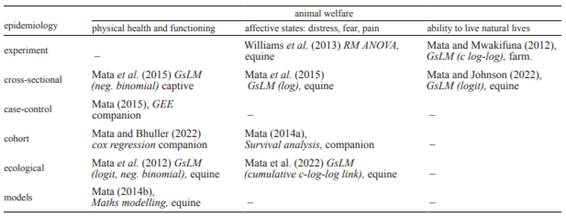Trabajo de Investigación
Vinculación epidemiológica, bioestadística y ciencia de bienestar animal
Linking epidemiology, biostatistics and animal welfare science
1Center for Research in Agri-Food Systems and Sustainability, Instituto Politécnico de Viana do Castelo, Portugal. E-mail: fernandomata@ipvc.pt
Resumen
Diferentes técnicas epidemiológicas y enfoques bioestadísticos se ubican en un contexto científico de bienestar animal, en una diversidad de especies y entornos, con referencia a una variedad de estudios proporcionados como ejemplos de referencia. La epidemiología es especialmente importante en la ciencia del bienestar animal, ya que permite el uso de entornos complejos fuera del contexto de laboratorio utilizando modelos que tienen en cuenta factores aleatorios. También es importante en la introducción de técnicas estandarizadas que permitan la síntesis de evidencia.
Palabras clave: bioestadística; labor colaborativa; epidemiología; multidisciplinariedad
Abstract
Different epidemiological techniques and bio-statistical approaches are put into an animal welfare scientific context, in a variety of species and settings, with reference to a variety of studies provided as examples for reference. Epidemiology is especially important in animal welfare science allowing the use of complex settings outside the laboratory environment using models that account for random factors. It is also important in the introduction of standardised techniques allowing evidence synthesis.
Key words: biostatistics; collaborative work; epidemiology; multidisciplinary; teamwork
Collaboration in animal welfare science
Epidemiology has been gaining visibility as a tool in the identification of risk factor posed in animal welfare science. It has been used with farm, wild, captive and companion animals 6. The advancement of science has been favoured by collaborative research between scientist of different fields of expertise 11.
Epidemiology has evolved during the 20th century from the study of infectious disease to a broad science from the cellular and individual level to population level 1, including the social determinants of heath, aggregated into the concept of one health. The concept of one health defines health as the same for humans and animals living under the same environment.
Epidemiologists work in multidisciplinary teams integrating health scientists, statisticians, and policymakers 1. Accordingly to the concept of one health, this concept can be extended further to all the life kingdoms, therefore health scientists may include human medicine, but also veterinaries, ecologists, sociologists, and many other fields.
It is under this umbrella that can be understood how important it is the capacity to bring in knowledge able to bridge the gaps between scientists with a deep but narrow expertise. Multiskilled individuals gain importance due to their capacity to integrate different expertise, promoting mutual understanding and contributing therefore, to bridge the gap between fields of expertise 6.
With these considerations in mind, animal welfare scientists need also to collaborate, with epidemiologists, and therefore biostatisticians. Epidemiology and biostatistics have shown to be important tools for animal welfare scientists to perform professionally with extended capacity in many situations.
The relationship between biostatistics, epidemiology and animal welfare has evolved from the end of the 20th century 12. The advantages in the use of epidemiological tools in animal welfare was since referred by several authors. This has been the case in risk assessment of environment, management, or genetics, whether in the laboratory or the field in animal settings such as aquaculture, farms, homes, zoos, and equine.
The range of statistical methods used in epidemiology is enormous, and techniques such as general linear models, generalized linear models, survival analysis, meta-analysis and mathematical modelling are widely used.
Table 1 gives examples of the different epidemiological study designs and biostatistical approaches, putting them in an animal welfare scientific context.
Acknowledgments
The author would like to acknowledge the Foundation for Science and Technology (FCT, Portugal) for financially supporting CISAS, IP-VC through the project UIDP/05937/2020, including the contract of the author.
References
1. Lau B et al. 2020. Perspectives on the future of epidemiology: a framework for training. Am J Epidemiol 189: 634-639.
[ Links ]
2. Mata F. 2013. Mastitis vaccination in dairy cattle: a meta-analysis of case-control trials. Revista Portuguesa de Ciências Veterinárias 108: 17-22.
[ Links ]
3. Mata F. 2014. Analysis of predisposition factors for limb amputation in dogs with survival analysis in those diagnosed with appendicular cancer. Veterinary Nurse 5: 406-411.
[ Links ]
4. Mata F. 2014. Evaluation of horse fitness for exercise: the use of a logit-log function to model horse post-exercise heart rate recovery. J Equine Vet Sci 34: 1055-1058.
[ Links ]
5. Mata F. 2015. The interactive effects of diet, age and teeth in the oral health of cats. Anim 5: 101-107.
[ Links ]
6. Mata F. 2021. A framework for using epidemiology in animal welfare science. J Appl Anim Welf Sci (epub ahead of print).
[ Links ]
7. Mata F, Johnson C, Bishop C. 2015. A cross-sectional epidemiological study of incidence of bit injuries in polo and race horses. J Appl Anim Welf Sci 18: 259-268.
[ Links ]
8. Mata F, Lam A. 2013. Investigating the relationship between feed and helminthic burden of captive birds of prey in Hong Kong. Zoo Biol 32: 652-654.
[ Links ]
9. Mata F, Mwakifuna B. 2012. Comparative mortality and predation in relation to egg production traits of Rhode Island Red, Black Australorp and Hyblack laying hens in scavenging production systems of rural Malawi. Brit Poultry Sci 53: 570-575.
[ Links ]
10. Mata F, Williams J, Marks F. 2012. Investigation of factors associated with the probability of racehorses being pulled up in steeplechase races at Cheltenham racetrack. Comp Exercise Physiol 8: 95-101.
[ Links ]
11. Scarazzati S, Wang L. 2019. The effect of collaborations on scientific research output: the case of nano-science in Chinese regions. Scientometrics 121: 839-868.
[ Links ]
12. Willeberg P. 1997. Epidemiology and animal welfare. Proceedings of the 8th International Symposium on Veterinary Epidemiology and Economics. Épidémiologie et Santé Animale, Paris, France.
[ Links ]
13. Williams J, Parrot R, Damata F. 2012. The effect of manual and motorised dental rasping instruments on thoroughbred heart rate and behaviour. J Vet Behav 7: 149-156.
[ Links ]















